The Workshop in my Bedroom
By Jonathan W. Murphy
Englishtown, New Jersey
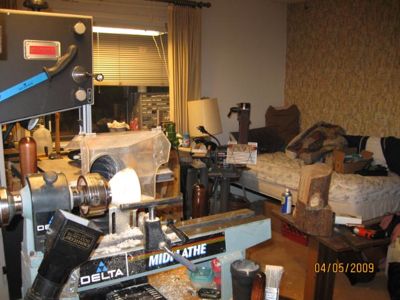 In his article in the January issue of
Wood News
, Dilo Ferdinando showed us the extreme in the small workshop.
I bow to his use of a closet, but I
am a bit more dependent on power tools than he is. (I did have a shop in a closet a few years back,
with a mini-lathe, bandsaw, grinder and drill press. My auxiliary
shop was my arm chair in the living room – with my beer and my TV and my hand tools.)
As time passed I accumulated more power tools and they expanded into the
bedroom – a table saw, a router table, a small belt/disc sander and a slow-speed wet
grinder.
In his article in the January issue of
Wood News
, Dilo Ferdinando showed us the extreme in the small workshop.
I bow to his use of a closet, but I
am a bit more dependent on power tools than he is. (I did have a shop in a closet a few years back,
with a mini-lathe, bandsaw, grinder and drill press. My auxiliary
shop was my arm chair in the living room – with my beer and my TV and my hand tools.)
As time passed I accumulated more power tools and they expanded into the
bedroom – a table saw, a router table, a small belt/disc sander and a slow-speed wet
grinder.
My lady friend of many years and I decided to consolidate our
living quarters and
jointly bought an apartment in NJ. May I say that in such a case, the recommendations I make here as to a bedroom
workshop suggest the need for an additional bedroom as well as a certain tolerance by the lady of the house.
I was on one leg when I built the workshop in our new place. It was fortunate that we had decided to move to a one-story condo before I
discovered I was to lose a leg. I now have a prosthetic leg, and have made some compromises in the
setup relating to my mobility.
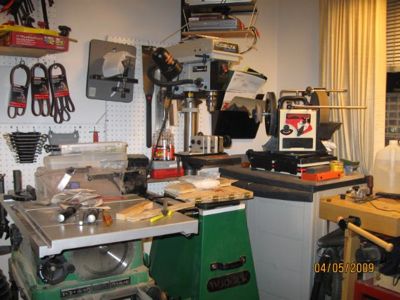 There are four criteria for making a small shop work within the confines of an apartment. The first
is the compromise as to what types of woodworking equipment you choose for outfitting your shop.
This will depend a lot on exactly what kind of
woodworking you like to do. The second is the mobility of your fixed machines. The
third is noise level, and the fourth is dust collection.
There are four criteria for making a small shop work within the confines of an apartment. The first
is the compromise as to what types of woodworking equipment you choose for outfitting your shop.
This will depend a lot on exactly what kind of
woodworking you like to do. The second is the mobility of your fixed machines. The
third is noise level, and the fourth is dust collection.
My main interests are wood turning and making musical
instruments, along with the general woodwork that one ends up doing. Consequentlty I need my lathe, which is an aged Delta Midi
– it is serial number 000000041.
In the years since the design of my ancient Delta, a number of manufacturers have come out with mini and midi lathes, and some offer
electronic variable speed motor options. Being able to adjust spindle speed by twisting a dial rather than moving the belt across step pulleys
is a real convenience, especially when doing small work. I have converted my old girl to variable speed
with an aftermarket product. The newer mini/midi's have varying characteristics – the swing over the ways,
the center to center maximum, the overall length (which impacts shop space) and such things as "indexing heads"
(which I have no need of for my work). Look to the work you want to do, the space you have, and your budget.
I have a bandsaw that is a bit bigger than most
small shops need – but as small as I can make it. The 12" Craftsman in the photos has a resaw
depth of 7", which is more than most 14" saws. The extra depth is handy for setting up lathe projects
and doing resawing for instrument ribs. I find the table saw a bit redundant – one could use a hand circular
saw and sawhorses to do the long rips and cross cuts – but it also provides an auxiliary table
for putting things on. The 10" drill press is
quite adequate for small shop work, but don't go too cheap. Make sure you have a racheted table
mount, as with a small drill press you will sometimes find the need to make a deeper cut than the
quill travel. The positive table adjustment is a help here.
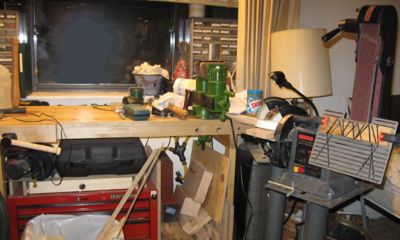 My Sjoberg workbench was a major expenditure.
I always wanted a proper workbench. I could have built one myself,
but as I was setting up the workshop I didn't have a bench to make it on.
The sound and solid top, finished with a protective coat of
a combination of lacquer, oil and wax, gives me a versatile table. In the
photo you will see a patternmaker's vise that is mounted in one of the pre-drilled 3/4" holes – I
can move it to other places on the bench if I need to. The combination of the standard mounted
woodworker's vises and the patternmaker's vise give me versatility – and I find that for most
cross cuts I just clamp the material and break out one of my Japanese-style hand saws. It is quicker
than setting up the table saw.
My Sjoberg workbench was a major expenditure.
I always wanted a proper workbench. I could have built one myself,
but as I was setting up the workshop I didn't have a bench to make it on.
The sound and solid top, finished with a protective coat of
a combination of lacquer, oil and wax, gives me a versatile table. In the
photo you will see a patternmaker's vise that is mounted in one of the pre-drilled 3/4" holes – I
can move it to other places on the bench if I need to. The combination of the standard mounted
woodworker's vises and the patternmaker's vise give me versatility – and I find that for most
cross cuts I just clamp the material and break out one of my Japanese-style hand saws. It is quicker
than setting up the table saw.
A comment on the Japanese hand saws. It is not necessarily that they are of better quality than ours – it is
all about the "pull cut." Some American companies make the "pull cut" saws now, and I have several. The
Japanese, with their emphasis on philosophy (it takes years to learn how to properly serve tea) say that
they respect the wood by drawing the cut to the heart of the sawyer. From the Western point of view, it is just a better
original idea for making a straight cut. Our traditional "push saws" allow us to cut faster by
laying body weight into the cut, but the "pull cut" is far more accurate as the flexible blade
doesn't bend – and that saves time in finishing.
 My wall of power tools looks as if it is limited in space, but that is where mobility comes in, as well as
organization. The drill press and the bandsaw are mounted on tables with wheels in the back
and a handle in front so they can easily be pulled out. The table levels are such that they
are above the neighboring tools so they don't have to be moved except for large workpieces. For me the table saw
is merely a convenience. I already had it. It is a lightweight contractor's saw that I can pull out
easily even on its own feet. Depending on the work you do, you may get by without it by using a
circular saw and sawhorses outside.
My wall of power tools looks as if it is limited in space, but that is where mobility comes in, as well as
organization. The drill press and the bandsaw are mounted on tables with wheels in the back
and a handle in front so they can easily be pulled out. The table levels are such that they
are above the neighboring tools so they don't have to be moved except for large workpieces. For me the table saw
is merely a convenience. I already had it. It is a lightweight contractor's saw that I can pull out
easily even on its own feet. Depending on the work you do, you may get by without it by using a
circular saw and sawhorses outside.
What about the floor? How do I make that the level and solid base that the tools require, and do it in my
bedroom? First, they don't require that perfect base. Machine tools of thousands of pounds in
professional shops require a perfect base, and the rest of us would like to have one. My flooring is
laid on the bedroom carpet – no way to make a level and solid base. My lady wouldn't have
permitted it, and besides that the base underneath the carpet is a gypsum that is uneven. My floor
is 2 x 4 foot panels of compressed board sold as "attic flooring" by Home Depot (it is tongue and
grooved on the long edge so I can make it solid one way, and tape the other joints – and cost me $5
a panel). Works well, and I laid that flooring while I was still without one of my legs. Level your
tool within itself, table to blade, rather than worrying about the absolute level.
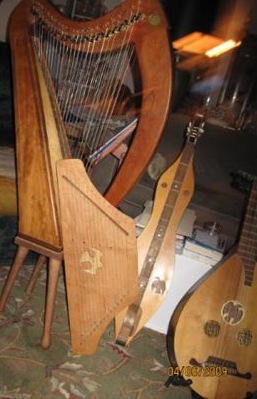 Let us discuss compromises. I don't have a great need for a router in my work, but did have a router
table combo. It has been donated to a school. I bought the Trend palm router (and Bosch makes a
similar one) that does all I need – and if I need to use a table with it I can build one. The
router table takes up space. As a luthier I do have to plane to thickness, and as a general
woodworker I also have to join edges. A power planer and a jointer would be nice, but they are both
large and expensive. I have a set of hand planes that do just as well – just a bit more work and
exercise. And for fine planing I have my Wagner SafeT planer which mounts on the
drill press, or my Luthier's Friend that I use for the fine tuning of instrument ribs. Each is
limited to 3", but by doubling the passes will handle 6". Beyond that, break out the hand plane.
Let us discuss compromises. I don't have a great need for a router in my work, but did have a router
table combo. It has been donated to a school. I bought the Trend palm router (and Bosch makes a
similar one) that does all I need – and if I need to use a table with it I can build one. The
router table takes up space. As a luthier I do have to plane to thickness, and as a general
woodworker I also have to join edges. A power planer and a jointer would be nice, but they are both
large and expensive. I have a set of hand planes that do just as well – just a bit more work and
exercise. And for fine planing I have my Wagner SafeT planer which mounts on the
drill press, or my Luthier's Friend that I use for the fine tuning of instrument ribs. Each is
limited to 3", but by doubling the passes will handle 6". Beyond that, break out the hand plane.
Pictured at left are some of the products I've made, although not in this workshop. My old place was smaller and much of
the work was done in the living room with hand tools. I could have made these more easily in this new
compact shop. From the left: a Celtic harp, a medieval psaltery, a mountain dulcimer and a Renaissance lute.
The flying bird soundhole is a trademark of mine.
Hand planes are another need in the small shop. They don't all have to be the best, but some
should be. My 14" jack plane is an "el cheapo". My 10" x 3" smoother is an expensive
one. An expensive skewed angle plane substitutes
for a far more expensive (and space-consuming) jointer. A couple of rough-hewn wooden planes with their
blades reshaped as "scrub planes" can take away the gross material when planing to thickness.
Then the cheap jack plane, then the good smoother. I won't get into block planes other than to say
that you need one good low angle block plane with a fine adjustment.
Another compromise, I need sharp well-shaped tools for my wood turning. I had a nice bench grinder
with an expensive Sorby gouge shaping jig. It is in the attic of the new place, awaiting an
appropriate home. I find the slow-speed wet grinder a pain in the butt when
reshaping a tool as it is too slow, but it is a gem at resharpening once the shape is established. A
bit of common sense, and the making of jigs out of scrap wood, can let you do the heavy grinding on
a cheap belt/disc sander combination. Better to take the extra time and not ruin expensive
tools. It takes me about ten hours to reshape and grind a skew chisel this way, and it would be ten
minutes on the bench grinder – but once done it is a clean shape and easily resharpened. Patience
is another requirement in the very small shop.
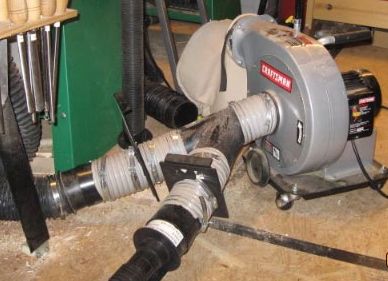 Dust collection is a problem in the small shop. The mobile dust collector you see in my photos is
quite practical in the way I have it set up. It is a bit underpowered, only 650 cfm, but I got it on sale
some years back for $100. There are similar devices at about $200 or more that pull 850 cfm. I'd go
with one of them if I were restarting. But the key to the use of the portable is to make it
versatile. By mounting a Y connector on the 4" input, and then
using blast gates on each wing of the Y, I can direct the draw of the collector. One wing is set for
a 2 1/2" hose, the other for a 4" - each with a pluggable connector. On the lathe I sometimes want to
draw dust from the back, and sometimes from the front, and sometimes both. It depends on the way I'm
cutting the workpiece. I can hook up the mobile collector and open the appropriate blast gates for
the process, and then use the relatively quiet (compared to the shop vac) dust collector to vacuum
the lathe area by shutting down the fixed 4" hose. The shop vac is there in the corner by the
workbench with a long hose for cleaning up when I really get ambitious. You will see fixed
connections on the bandsaw for the mobile dust collector, a 4" and a 2-1/2", and I've got a small
magnetic "hood" for the drill press, although I find that it is generally easier to just drill
away and immediately use the shop vac as the chips don't fly far.
Dust collection is a problem in the small shop. The mobile dust collector you see in my photos is
quite practical in the way I have it set up. It is a bit underpowered, only 650 cfm, but I got it on sale
some years back for $100. There are similar devices at about $200 or more that pull 850 cfm. I'd go
with one of them if I were restarting. But the key to the use of the portable is to make it
versatile. By mounting a Y connector on the 4" input, and then
using blast gates on each wing of the Y, I can direct the draw of the collector. One wing is set for
a 2 1/2" hose, the other for a 4" - each with a pluggable connector. On the lathe I sometimes want to
draw dust from the back, and sometimes from the front, and sometimes both. It depends on the way I'm
cutting the workpiece. I can hook up the mobile collector and open the appropriate blast gates for
the process, and then use the relatively quiet (compared to the shop vac) dust collector to vacuum
the lathe area by shutting down the fixed 4" hose. The shop vac is there in the corner by the
workbench with a long hose for cleaning up when I really get ambitious. You will see fixed
connections on the bandsaw for the mobile dust collector, a 4" and a 2-1/2", and I've got a small
magnetic "hood" for the drill press, although I find that it is generally easier to just drill
away and immediately use the shop vac as the chips don't fly far.
And that brings up another matter – the mobility of the workman as it relates to the noise of the tools. In a shop
that is in an apartment, and more so in a bedroom of an apartment, there is a major noise issue. My
dust collector is relatively quiet on a "through-the-walls basis," although I can't hear my TV
when it is running. As I'm less mobile than most, having one prosthetic leg, I do like to have
immediate control of the dust collector without moving. I spent the inordinate sum of about $40 to
have a remote control for the collector – I can be turning on the lathe or cutting on the bandsaw
and shut down the collector without moving from my bar stool. I have my shop vac connected through
an on/off foot switch that is on a long enough cord that I can have it close to where I'm cleaning
up. I have a "dead man's" foot switch for the table saw so I can chop the power as soon as the cut
is made. That is both a safety and noise consideration.
The conventional wisdom, and properly so, is that one should use one's tools while standing up. One
has better control when using the full body movement rather than small hand and arm movements. I
agree, but I have to break the rules. The bar stool I have in my shop is not because I'm lazy. It's just
that I sit as much as I can because the pressure on the prosthetic leg can be a bit annoying, and
counter-productive when it becomes painful. So my small shop needs extra room for my bar stool. If
any of you have a similar problem, let me suggest that you do the gross work sitting down, but
stand up to the machine when doing sensitive, precise work.
My wet sharpener is set too high for the optimum, but the cabinet it rests on provides me storage – I can
adjust my use of the tool to compensate for the extra height.
This type of wet grinder (of which the premium make is the Tormek – I have the Jet knock-off) is awkward to use if
one can't access it from both sides. In a cramped space one has to be able to turn them
around. Easy enough to make a rotating mount from a couple of pieces of wood and a TV turntable, and
set positive stops.
My choice of tools will not be yours. Each of us does different work, and there's
more than one way to skin a cat. In a small shop, compromise your choice of power tools
to have the best for your main work, and then do a lot of hand work for the rest. Ensure that you have
the space for the common activities. For instance, my bandsaw table is well above the lathe and the table saw,
and so is the drill press table. I have space for longer pieces to pass above the lathe and table
saw, but in extremis I can move any of the tools out of the way with one hand. One must plan ahead for projects
to save setup time, but one can fit a lot of stuff in a small space.
Jon Murphy, 73, of Englishtown, NJ can be reached at
jon@murphsays.com
.
Return to
Wood News
front
page